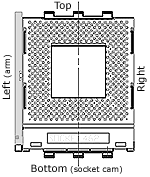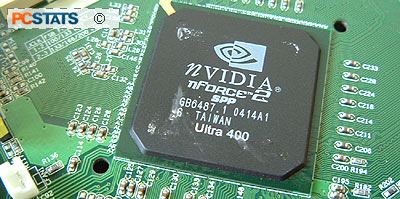 If you have a long 8X AGP videocard, you'll have
to remove it when accessing the DIMM slots on the
Epox 8RDA6+ PRO... That's the price one has to pay when the motherboard has
six PCI slots and is primed for expansion.
If you have a long 8X AGP videocard, you'll have
to remove it when accessing the DIMM slots on the
Epox 8RDA6+ PRO... That's the price one has to pay when the motherboard has
six PCI slots and is primed for expansion.
Epox illustrate good foresight by
including a secondary Silicon Image Serial ATA/RAID controller with the
motherboard. Serial ATA is the way of the future, and equipping a motherboard with
more than two IDE channels may be counterproductive.
In the past
we've complained about the type of nForce2
Northbridge cooling Epox has employed, but this time around the active
heatsink is a little more up to the task. It is uses a thermal pad
between the heatsink and Northbridge, so you may want to scrape that off and
apply some good quality silicon-based thermal paste. Because nVidia's MCP Southbridge also generates
a lot of heat, the Epox 8RDA6+ PRO also has a small passive heatsink installed on
it.
Heatsink Socket Clearances
| pcstats heatsink
clearance measurements |
| top
clearance: |
14 mm |
| bottom
(cam) clearance: |
7 mm |
|
| left side
(arm) clearance: |
36 mm |
| right
side clearance |
14 mm |
|
| socket
mounting holes: |
4 mm |
| max.
heatsink base dimensions: |
~79x76 mm |
|
 Note: Approx. measurements are made from
the edge of the socket (not the clips) to the closest obstacle
taller than the ZIF socket itself. Note: Approx. measurements are made from
the edge of the socket (not the clips) to the closest obstacle
taller than the ZIF socket itself.
The socket is 51mm across, and 62mm from top to
bottom. | |
 |
The Epox 8RDA6+ PRO has plenty
of space around the CPU socket for enthusiasts to install those "crazy" sized
heatsinks we all admire. On the plus side, the board even has the Socket A
mounting holes in the PCB.
Overclocking the Epox 8RDA6+ Pro
 When one talks
about an Epox motherboard, the topic of overclocking is bound to come up rather
soon. With respect to the Epox 8RDA6+ Pro, we first lowered the CPU multiplier
to 8x so the processor would not end up being the limiting factor, then started
to raise the FSB slowly.
When one talks
about an Epox motherboard, the topic of overclocking is bound to come up rather
soon. With respect to the Epox 8RDA6+ Pro, we first lowered the CPU multiplier
to 8x so the processor would not end up being the limiting factor, then started
to raise the FSB slowly.
At about 210 MHz FSB the
8RDA6+ Pro hit a few stability problems and so we had to raise the chipset
voltage to 1.8V to stabilize things. At 214MHz the memory started to flake out,
but raising the
Corsair TwinX1024-3200XL
PRO memory voltage to 2.8V, solved
that.
In the end, the Epox 8RDA6+
Pro maxed out at 216 MHz FSB, which is certainly a bit disappointing considering
the board is an Epox... Oh well, there are a lot of other good qualities about
this nForce2 Ultra 400 based motherboard....
